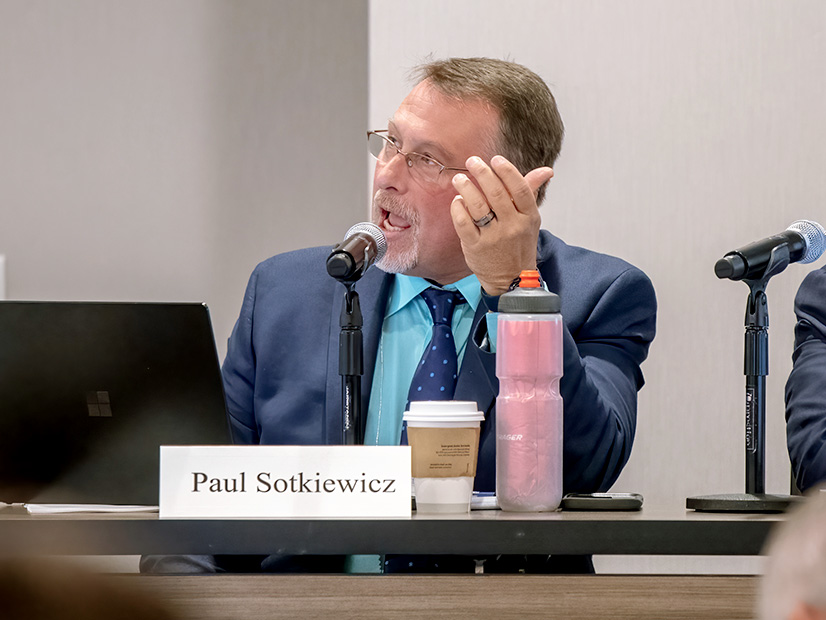
The PJM Markets and Reliability Committee (MRC) voted Oct. 25 to approve the creation of a fifth cost of new entry (CONE) area for the Commonwealth Edison (ComEd) zone to reflect an expectation that the Illinois Climate and Equitable Jobs Act (CEJA) will shorten the lifespan for combined cycle generators — the current reference resource CONE values are based on.
The vote capped months of discussions of how to reflect particularities at the local and state level that could affect the inputs in calculating the cost to build the reference resource, a subject broached by J-Power USA in a protest to PJM’s 2022 quadrennial review filing. The company argued that new combined cycle resources would be forced into retirement within the 20-year amortization period included in the CONE calculation due to the legislation’s requirement that generators have zero carbon emissions by 2045. (See “J-Power Critiques Amortization Period,” PJM Defends Quadrennial Review Parameters from Generator Protests.)
The vote, which carried 80% support, came after a motion from the Illinois Citizens Utility Board (CUB) to defer the vote by a month failed after receiving 46.7% support against the two-thirds sector-weighted threshold needed to pass. Clara Summers of the Illinois CUB said that the delay would have provided more time to evaluate the effect of the proposal and potentially develop an alternative or amendments to the package. In particular, she expressed concern the proposal had no mechanism for reevaluating whether the ComEd-specific net CONE zone is providing relevant price signals as we near 2045, the expected end date for the combined cycle reference resource.
The proposal was endorsed by the Members Committee following the Oct. 25 MRC vote. A motion to defer the vote made by Summers was rejected by the MC as well.
She argued the legislation could affect inputs used to calculate CONE beyond the reference resource asset life, including the energy and ancillary service (E&AS) revenue offset.
“This proposal focuses on one factor in setting net CONE, asset life, because of CEJA … but CEJA also has an impact on things like the E&AS offsets,” Summers said before motioning to defer the vote.
She also pointed to comments PJM made in support of its quadrennial review filing at FERC stating there hasn’t been a holistic analysis of CEJA’s impact on CONE and that creating a region to account for legislation in Illinois could establish a precedent for creating CONE areas across several states and localities to account for various policies. Instead of establishing a new CONE area to account for specific legislation in one state, she said creating a clear standard for when a new area is warranted would be preferable.
Zachary Callen of the Illinois Commerce Commission said commission staff are not opposed to creating a new CONE area on principal, but he believes it’s a complicated subject that hasn’t had enough stakeholder discussion.
“It does give us pause that this is a really Illinois- and CEJA-specific policy and what we’d like to see more is something more rules-based,” he said.
He said the tightened Base Residual Auction schedule over the next few years would provide little time for policy makers, load and generation to respond to price signals based on a new CONE area. Given PJM’s analysis that the effect would be minimal at first, Callen suggested it may be better to wait until the next quadrennial review to make the change and to use the additional time to conduct more research.
Paul Sotkiewicz, president of E-cubed Policy Associates, said he had brought an alternative proposal that would have automatically created a new CONE area when policies affecting a region affected CONE inputs. He withdrew the package out of a desire to have the reduced asset life implemented in time for the 2025/26 auction. The further in advance the change is made, the less sharp any change in CONE values would be, he said.
“It’s important to send those signals about reliability sooner rather than later, rather than have everything fall off a cliff” and risk a larger rate shock, Sotkiewicz said.
PJM’s Gary Helm said the new area would have a CONE value of $201,714/MW-year, higher than any of the existing four areas. CONE Area 3, which ComEd is a part of, has a value of $197,800/MW-year. The proposal would affect only the reference resource asset life factor, based on the assumption that natural gas resources will retire based on CEJA’s requirement that those generators reduce their emissions to zero by 2045.
Helm said waiting until the next quadrennial review would mean any changes would not be implemented until the 2030/31 delivery year, well into the period that PJM has stated it’s concerned about resource adequacy as loads increase and fossil generation retires. He said that the proposal is part of a larger strategy for maintaining resource adequacy and that making the changes at this time would avoid a sudden change in capacity prices.
The motion to defer was supported predominantly by the electric distributor and end-use customer sectors, with about 90% support in both categories. The other supplier and generation owner sectors were strongly opposed and transmission owners more mixed about the proposal, with 40% support. When the vote shifted to the actual proposal to create a fifth cone area, the transmission owner, other supplier and generation owner sectors were unanimous in their support, while 70% of the electric distributor sector and 46.2% of end-use customers voted in support at the MRC.


